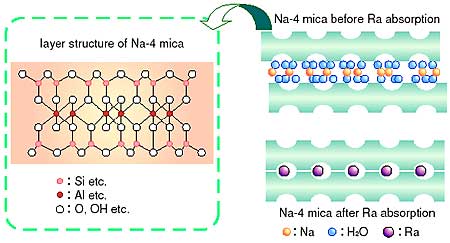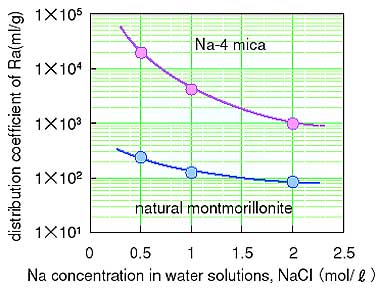Many materials are obtained from soils and rock. In their mining and production industries, mill tailings and slag are the main wastes. The wastes arising from uranium and rare earth elements industries contain radioactive radium (Ra). The Ra is one of the typical natural radioactive materials and is soluble in water. Therefore, it is required to develop a means to avoid its spread in our environment.
In the studies on the reaction between Ra and materials, it has been found that synthetic clay 'Na-4 mica' selectively absorbs Ra and becomes a geologically stable mineral. It has a nominal composition of Na4Al4Si4Mg6O20F4 xH2O, and has a layer stacking structure, as shown in Fig. 7-1. Sodium (Na) and H2O are originally absorbed between the layers. Radium readily substitutes them and stabilizes the structure. This is because that the negatively charged Na-4 mica has a higher absorptivity to Ra2+ than that to Na+, and also Na+ hydrates more water molecules than Ra2+. xH2O, and has a layer stacking structure, as shown in Fig. 7-1. Sodium (Na) and H2O are originally absorbed between the layers. Radium readily substitutes them and stabilizes the structure. This is because that the negatively charged Na-4 mica has a higher absorptivity to Ra2+ than that to Na+, and also Na+ hydrates more water molecules than Ra2+.
The comparison of Ra absorption behavior is shown in Fig. 7-2 for Na-4 mica and natural montmorillonite. The distribution coefficient is a ratio of amount of Ra absorbed / amount of Ra in solution. The values for Na-4 mica are more than 200 times larger than those for montmorillonite in low Na concentration regions, and sharply increase with decrease of Na concentration. From these results, Na-4 mica seems to be useful for the separation and immobilization of Ra in environmental water with low Na concentrations. The Na-4 mica is readily synthesized from natural kaolinite Al2Si2O5(OH)4, magnesia MgO and others.
By taking advantage of the results obtained, engineering developments continue for the purification of environmental water and the cleanup of soils contaminated by heavy metals. |


 xH2O, and has a layer stacking structure, as shown in Fig. 7-1. Sodium (Na) and H2O are originally absorbed between the layers. Radium readily substitutes them and stabilizes the structure. This is because that the negatively charged Na-4 mica has a higher absorptivity to Ra2+ than that to Na+, and also Na+ hydrates more water molecules than Ra2+.
xH2O, and has a layer stacking structure, as shown in Fig. 7-1. Sodium (Na) and H2O are originally absorbed between the layers. Radium readily substitutes them and stabilizes the structure. This is because that the negatively charged Na-4 mica has a higher absorptivity to Ra2+ than that to Na+, and also Na+ hydrates more water molecules than Ra2+.